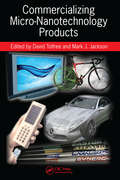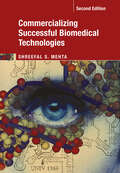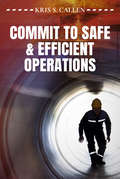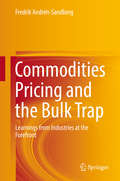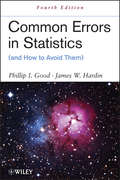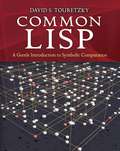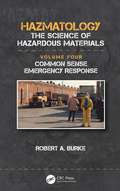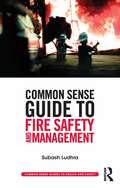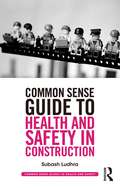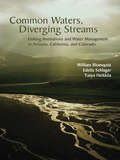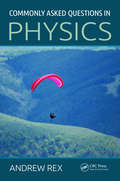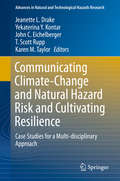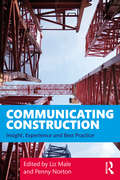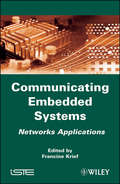- Table View
- List View
Commercialization Secrets for Scientists and Engineers
by Michael SzycherCommercializing a knowledge-based product or service requires a realistic, methodical approach combined with a great deal of perseverance. Commercialization Secrets for Scientists and Engineers serves as a high-level guide to answering key questions and critical issues that confront founding entrepreneurs on their quest to commercialize their knowledge-based innovations. It highlights the unique problems shared by all technologists across knowledge-intensive fields and how to overcome the most predictable obstacles faced by technology entrepreneurs. It demystifies the process of commercializing advanced products that require a high degree of specialized knowledge. Typically, these are "disruptive technologies" with the potential to revolutionize whole industries. The book simplifies the launch of high-tech ventures such as pharmaceuticals, genetic and biotechnology products, wireless devices, fuel cells, and minimally invasive medical devices. Additionally, it will help readers bring their disruptive technologies to profitability.
Commercialization of Nanotechnologies–A Case Study Approach: A Case Study Approach
by Fatima Zivic Eva Pellicer Jordi Sort Nenad Grujovic Dermot Brabazon Maria Dolors Baró Kwang-Leong ChoyThis book covers diverse areas in which nanoscience and nanotechnology have led to significant technological advances and practical applications, with special emphasis on novel types of nanomaterials and their applicability into a new generation of nano- and micro-devices. Different nanomaterials are reviewed with a focus on several practical application areas and their commercial utilization. Production technologies of nanomaterials are presented as one of the challenges today. Sectors where nanotechnology has already significantly contributed are presented, along with specific nanotechnology solutions: energy related sectors, NEMS/MEMS, micro power generators, spintronics and healthcare. The basic properties and applications of nanostructured thermoelectric materials, ferroelectric and piezoelectric nanomaterials are reviewed. Examples of several developed thin-film thermogenerators are shown. A review of existing solutions and developing challenges are given regarding sustainable energy production, photovoltaics, solar cells, hydrogen economy and improved classes of batteries as contributions to green products and circular economy. Novel, highly promising areas in nanotechnology, are shown, such as voltage-driven nano-spintronics. Recent advances in friction characterisation at the nano level are described. Several proven nanomaterials have been reviewed pertaining to biomedicine. The use of nanomaterials in ophthalmology and cosmetic industry are reviewed, and the potential for silver nanoparticles and iron-based nanomaterials in biomedicine, also with recognised challenges and possible threats of non-controlled use of nanomaterials. This work is the result of joint efforts of different companies, academic, and research institutions participating in WIMB Tempus project, 543898-TEMPUS-1-2013-1-ES-TEMPUS-JPHES, "Development of Sustainable Interrelations between Education, Research and Innovation at WBC Universities in Nanotechnologies and Advanced Materials where Innovation Means Business", co-funded by the Tempus Programme of the European Union.
Commercializing Micro-Nanotechnology Products
by Mark J. Jackson David TolfreeMicro-nanotechnologies (MNT) are already making a profound impact on our daily lives. New applications are well underway in the US, Asia, and Europe. However, their potentially disruptive nature, along with the public's concerns, has produced a number of challenges. Commercializing Micro-Nanotechnology Products provides a snapshot of the cur
Commercializing Nanotechnology: A Roadmap to Taking Nanoproducts from Laboratory to Market
by Hebab A. QuaziCommercializing Nanotechnology: A Roadmap to Taking Nanoproducts from Laboratory to Market provides a step-by-step roadmap for taking the results of laboratory research on nanotechnology and nanomaterials and developing them into successful and profitable commercial ventures. It details the methodology, techniques, and pathways for technology-readiness assessment, testing protocols, and commercialization, and it discusses manufacturing techniques, including their limitations and challenges. Provides methodology, techniques, and pathways for technology-readiness assessment, testing protocols, and commercialization Offers general direction and assistance to researchers Describes manufacturing techniques, including their limitations and challenges Discusses intellectual property protection Provides details on market opportunities This book is aimed at scientists and engineers, including chemists, physicists, economists, medical practitioners, managers, marketers, traders, investors, and entrepreneurs in the fields of nanoscience, nanomedicine, nanoengineering, and nanomanufacturing.
Commercializing New Technologies: Getting from Mind to Market
by Vijay K. JollyThe author tackles the issue of technology commercialization, characterizing it as a dynamic process that proceeds through five stages: 1) imagining, 2) incubating, 3) demonstrating, 4) promoting, and 5) sustaining.
Commercializing Successful Biomedical Technologies: Basic Principles For The Development Of Drugs, Diagnostics And Devices
by Shreefal S. MehtaTransform your research into commercial biomedical products with this revised and updated second edition. Covering drugs, devices and diagnostics, this book provides a step-by-step introduction to the process of commercialization, and will allow you to create a realistic business plan to develop your ideas into approved biomedical technologies. This new edition includes: Over 25% new material, including practical tips on startup creation from experienced entrepreneurs. Tools for starting, growing and managing a new venture, including business planning and commercial strategy, pitching investors, and managing operations. Global real-world case studies, including emerging technologies such as regulated medical software and Artificial Intelligence (AI), offer insights into key challenges and help illustrate complex points. Tips and operational tools from established industry insiders, suitable for graduate students and new biomedical entrepreneurs.
Commit to Safe & Efficient Operations
by Kris Callen"Commit to Safe and Efficient Operations" is a road-map (recipe) for transforming your organization, division or team's safety culture.
Commodities Pricing and the Bulk Trap: Learnings from Industries at the Forefront
by Fredrik Andrén-SandbergThis book takes a fresh look at pricing, product differentiation and the need for decommoditisation in market sectors where products and services are standardised and interchangeable. In the first chapters the book explains what commodities are, and puts them into a historical perspective to promote an understanding of their production and its effects. From this baseline the book then presents a case study on how decommoditisation has progressed within the energy industry. Building on this case study and learnings from other sectors, it develops a theoretical framework, characterising the processes and mechanisms observed to be extended towards different industries. This framework is then utilised in the following chapters as a model to explain the progression of decommoditisation, and to examine other sectors through this lens. To conclude, the book presents the implications for stakeholders and suggestions on how to respond to them from a policy and business standpoint. In a final chapter the book develops an outlook on current trends and possible alternative pathways, and summarizes the main takeaways for management professionals and policymakers alike.
Common Circuits: Hacking Alternative Technological Futures
by Luis Felipe MurilloHow hackers facilitate community technology projects that counter the monoculture of "big tech" and point us to brighter, innovative horizons. A digital world in relentless movement—from artificial intelligence to ubiquitous computing—has been captured and reinvented as a monoculture by Silicon Valley "big tech" and venture capital firms. Yet very little is discussed in the public sphere about existing alternatives. Based on long-term field research across San Francisco, Tokyo, and Shenzhen, Common Circuits explores a transnational network of hacker spaces that stand as potent, but often invisible, alternatives to the dominant technology industry. In what ways have hackers challenged corporate projects of digital development? How do hacker collectives prefigure more just technological futures through community projects? Luis Felipe R. Murillo responds to these urgent questions with an analysis of the hard challenges of collaborative, autonomous community-making through technical objects conceived by hackers as convivial, shared technologies. Through rich explorations of hacker space histories and biographical sketches of hackers who participate in them, Murillo describes the social and technical conditions that allowed for the creation of community projects such as anonymity and privacy networks to counter mass surveillance; community-made monitoring devices to measure radioactive contamination; and small-scale open hardware fabrication for the purposes of technological autonomy. Murillo shows how hacker collectives point us toward brighter technological futures—a renewal of the "digital commons"—where computing projects are constantly being repurposed for the common good.
Common Errors in Statistics (and How to Avoid Them): Introduction To Statistics Through Resampling Methods And Microsoft Office Excel
by Phillip I. Good James W. HardinPraise for Common Errors in Statistics (and How to Avoid Them) "A very engaging and valuable book for all who use statistics in any setting." —CHOICE "Addresses popular mistakes often made in data collection and provides an indispensable guide to accurate statistical analysis and reporting. The authors' emphasis on careful practice, combined with a focus on the development of solutions, reveals the true value of statistics when applied correctly in any area of research." —MAA Reviews Common Errors in Statistics (and How to Avoid Them), Fourth Edition provides a mathematically rigorous, yet readily accessible foundation in statistics for experienced readers as well as students learning to design and complete experiments, surveys, and clinical trials. Providing a consistent level of coherency throughout, the highly readable Fourth Edition focuses on debunking popular myths, analyzing common mistakes, and instructing readers on how to choose the appropriate statistical technique to address their specific task. The authors begin with an introduction to the main sources of error and provide techniques for avoiding them. Subsequent chapters outline key methods and practices for accurate analysis, reporting, and model building. The Fourth Edition features newly added topics, including: Baseline data Detecting fraud Linear regression versus linear behavior Case control studies Minimum reporting requirements Non-random samples The book concludes with a glossary that outlines key terms, and an extensive bibliography with several hundred citations directing readers to resources for further study. Presented in an easy-to-follow style, Common Errors in Statistics, Fourth Edition is an excellent book for students and professionals in industry, government, medicine, and the social sciences.
Common LISP: A Gentle Introduction to Symbolic Computation
by David S. TouretzkyThis highly accessible introduction to Lisp is suitable both for novices approaching their first programming language and experienced programmers interested in exploring a key tool for artificial intelligence research. The text offers clear, reader-friendly explanations of such essential concepts as cons cell structures, evaluation rules, programs as data, and recursive and applicative programming styles. The treatment incorporates several innovative instructional devices, such as the use of function boxes in the first two chapters to visually distinguish functions from data, use of evaltrace notation in later chapters to illustrate the operation of evaluation rules, and "Dragon stories" to explain recursion. The book contains nearly 400 diagrams and illustrations, and 77 pages of answers to exercises. Advanced topics and "toolkit" sections, and a variety of complete programs, extend readers' programming power.
Common Rail Fuel Injection Technology in Diesel Engines
by Guangyao Ouyang Shijie An Zhenming Liu Yuxue LiA wide-ranging and practical handbook that offers comprehensive treatment of high-pressure common rail technology for students and professionals In this volume, Dr. Ouyang and his colleagues answer the need for a comprehensive examination of high-pressure common rail systems for electronic fuel injection technology, a crucial element in the optimization of diesel engine efficiency and emissions. The text begins with an overview of common rail systems today, including a look back at their progress since the 1970s and an examination of recent advances in the field. It then provides a thorough grounding in the design and assembly of common rail systems with an emphasis on key aspects of their design and assembly as well as notable technological innovations. This includes discussion of advancements in dual pressure common rail systems and the increasingly influential role of Electronic Control Unit (ECU) technology in fuel injector systems. The authors conclude with a look towards the development of a new type of common rail system. Throughout the volume, concepts are illustrated using extensive research, experimental studies and simulations. Topics covered include: Comprehensive detailing of common rail system elements, elementary enough for newcomers and thorough enough to act as a useful reference for professionals Basic and simulation models of common rail systems, including extensive instruction on performing simulations and analyzing key performance parameters Examination of the design and testing of next-generation twin common rail systems, including applications for marine diesel engines Discussion of current trends in industry research as well as areas requiring further study Common Rail Fuel Injection Technology is the ideal handbook for students and professionals working in advanced automotive engineering, particularly researchers and engineers focused on the design of internal combustion engines and advanced fuel injection technology. Wide-ranging research and ample examples of practical applications will make this a valuable resource both in education and private industry.
Common Rail System for GDI Engines: Modelling, Identification, and Control (SpringerBriefs in Electrical and Computer Engineering)
by Angelo Palladino Alessandro Di Gaeta Veniero Giglio Giovanni FiengoProgressive reductions in vehicle emission requirements have forced the automotive industry to invest in research and development of alternative control strategies. Continual control action exerted by a dedicated electronic control unit ensures that best performance in terms of pollutant emissions and power density is married with driveability and diagnostics. Gasoline direct injection (GDI) engine technology is a way to attain these goals. This brief describes the functioning of a GDI engine equipped with a common rail (CR) system, and the devices necessary to run test-bench experiments in detail. The text should prove instructive to researchers in engine control and students are recommended to this brief as their first approach to this technology. Later chapters of the brief relate an innovative strategy designed to assist with the engine management system; injection pressure regulation for fuel pressure stabilization in the CR fuel line is proposed and validated by experiment. The resulting control scheme is composed of a feedback integral action and a static model-based feed-forward action, the gains of which are scheduled as a function of fundamental plant parameters. The tuning of closed-loop performance is supported by an analysis of the phase-margin and the sensitivity function. Experimental results confirm the effectiveness of the control algorithm in regulating the mean-value rail pressure independently from engine working conditions (engine speed and time of injection) with limited design effort.
Common Sense Emergency Response
by Robert A. BurkeWritten by a hazardous materials consultant with over 40 years of experience in emergency services, the five-volume Hazmatology: The Science of Hazardous Materials, suggests a new approach dealing with the most common aspects of hazardous materials, containers, and the affected environment. It focuses on innovations in decontamination, monitoring instruments, personal protective equipment in a scientific way utilizing common sense, and takes a risk-benefit approach to hazardous material response. This set provides the reader with a hazardous materials "Tool Box" and a guide for learning which tools to use under what circumstances.Options for stabilization can very widely depending on the scope and size of the incident and the hazards involved. Volume Four, Common Sense Emergency Response, covers this process and includes science and risk analysis and the part it plays in a successful outcome of the stabilization portion of the response. FEATURES Offers a risk-benefit approach based upon science and history Provides an exploration of current research Outlines a systematic approach based on science and risk management Includes hazmat case studies Focuses on common sense utilization of hazmat tool box
Common Sense Guide to Environmental Management
by Subash LudhraAn essential and short guide for those who need to know more about environmental management in the workplace without wanting to spend hours reading dozens of different documents. Whether it’s for use alongside a training course or simply to brush up on your knowledge, it’s perfect for equipping you with the principles of environmental management. Friendly and accessible, this Common Sense Guide covers all the main aspects of environmental management in manageable chapters to provide you with the knowledge and understanding you need to look after the environment and those around you. Suitable for those with little understanding of environmental management Includes questions at the end of each module to consolidate your environmental management knowledge Certificate offered to those who complete the exam at the end of the book and return to be marked externally.
Common Sense Guide to Fire Safety and Management
by Subash LudhraAn essential and short guide for those who need to know more about fire safety and management without wanting to spend hours reading dozens of different documents. Whether it’s for use alongside a training course or simply to brush up on your knowledge, it’s perfect for equipping you with the principles of fire safety. Friendly and accessible, this Common Sense Guide covers all the main aspects of fire safety and management in manageable chapters to provide you with the knowledge and understanding you need to look after yourself and others. Suitable for those with little understanding of fire safety and management Includes questions at the end of each module to consolidate your fire safety knowledge Certificate offered to those who complete the exam at the end of the book and return to be marked externally.
Common Sense Guide to Health & Safety at Work
by Subash LudhraAn essential and short guide for employees who need to know more about health and safety in the workplace without wanting to spend hours reading dozens of different documents. Whether it’s for use alongside a training course or simply to brush up on your knowledge, it’s perfect for equipping you with the principles of health and safety. Friendly and accessible, this Common Sense Guide covers all the main aspects of health and safety in manageable chapters to provide you with the knowledge and understanding you need to look after yourself and others in the workplace. Suitable for the non-health and safety professional Includes questions at the end of each module to consolidate your health and safety knowledge Certificate offered to those who complete the exam at the end of the book and return to be marked externally.
Common Sense Guide to Health and Safety in Construction
by Subash LudhraAn essential and short guide for employees who need to know more about health and safety within the construction industry without wanting to spend hours reading dozens of different documents. Whether it’s for use alongside a training course or simply to brush up on your knowledge, it’s perfect for equipping you with the principles of health and safety in the construction industry. Friendly and accessible, this Common Sense Guide covers all the main aspects of health and safety in manageable chapters to provide you with the knowledge and understanding you need to look after yourself and others working in construction. Suitable for the non-health and safety professional Includes questions at the end of each module to consolidate your health and safety knowledge Certificate offered to those who complete the exam at the end of the book and return to be marked externally.
Common Sense Guide to International Health and Safety
by Subash LudhraAn essential and short guide for employees who need to know more about international health and safety without wanting to spend hours reading dozens of different documents. Whether it’s for use alongside a training course or simply to brush up on your knowledge, it’s perfect for equipping you with the principles of international health and safety. Friendly and accessible, this Common Sense Guide covers all the main aspects of international health and safety in manageable chapters to provide you with the knowledge and understanding you need in the international workplace. Suitable for the non-health and safety professional Includes questions at the end of each module to consolidate your health and safety knowledge Certificate offered to those who complete the exam at the end of the book and return to be marked externally
Common Waters, Diverging Streams: Linking Institutions and Water Management in Arizona, California, and Colorado
by Tanya Heikkila William Blomquist Edella SchlagerThis book is a firsthand investigation into water management in a fast-growing region of the arid American West. It presents three states that have adopted the conjunctive management of groundwater and surface water to make resources go further in serving people and the environment. Yet conjunctive management has followed a different history, been practiced differently, and produced different outcomes in each state. The authors question why different results have emerged from neighbors trying to solve similar problems with the same policy reform. Common Waters, Diverging Streams makes several important contributions to policy literature and policymaking. The first book on conjunctive water management, it describes how the policy came into existence, how it is practiced, what it does and does not accomplish, and how institutional arrangements affect its application. A second contribution is the book's clear and persuasive links between institutions and policy outcomes. Scholars often declare that institutions matter, but few articles or books provide an explicit case study of how policy linkages work in actual practice. In contrast, Blomquist, Schlager, and Heikkila show how diverging courses in conjunctive water management can be explained by state laws and regulations, legal doctrines, the organizations governing and managing water supplies, and the division of authority between state and local government. Not only do these institutional structures make conjunctive management easier or harder to achieve, but they influence the kinds of problems people try to solve and the purposes for which they attempt conjunctive management.
Commonly Asked Questions in Physics
by Andrew RexIn the 300 years since Newton's seminal work, physics has explained many things that used to be mysterious. Particularly in the last century, physics has addressed a range of questions, from the smallest fundamental particles to the large-scale structure and history of the entire universe. But there are always more questions.Suitable for a wide aud
Communicating Climate Change: A Guide for Educators (Cornell Series in Environmental Education)
by Marianne E. Krasny Anne K. Armstrong Jonathon P. SchuldtEnvironmental educators face a formidable challenge when they approach climate change due to the complexity of the science and of the political and cultural contexts in which people live. There is a clear consensus among climate scientists that climate change is already occurring as a result of human activities, but high levels of climate change awareness and growing levels of concern have not translated into meaningful action. Communicating Climate Change provides environmental educators with an understanding of how their audiences engage with climate change information as well as with concrete, empirically tested communication tools they can use to enhance their climate change program.Starting with the basics of climate science and climate change public opinion, Armstrong, Krasny, and Schuldt synthesize research from environmental psychology and climate change communication, weaving in examples of environmental education applications throughout this practical book. Each chapter covers a separate topic, from how environmental psychology explains the complex ways in which people interact with climate change information to communication strategies with a focus on framing, metaphors, and messengers. This broad set of topics will aid educators in formulating program language for their classrooms at all levels. Communicating Climate Change uses fictional vignettes of climate change education programs and true stories from climate change educators working in the field to illustrate the possibilities of applying research to practice. Armstrong et al, ably demonstrate that environmental education is an important player in fostering positive climate change dialogue and subsequent climate change action.Thanks to generous funding from Cornell University, the ebook editions of this book are available as Open Access from Cornell Open (cornellopen.org) and other Open Access repositories.
Communicating Climate-Change and Natural Hazard Risk and Cultivating Resilience: Case Studies for a Multi-disciplinary Approach (Advances in Natural and Technological Hazards Research #45)
by Jeanette L. Drake Yekaterina Y. Kontar John C. Eichelberger T. Scott Rupp Karen M. TaylorThis edited volume emphasizes risk and crisis communication principles and practices within the up-to the minute context of new technologies, a new focus on resiliency, and global environmental change. It includes contributions from experts from around the globe whose research, advocacy, teaching, work, or service in the natural or social sciences deals with risk communication and/or management surrounding natural and technological disasters, with a particular focus on climate change-related phenomena. Resilience and good communication are intimately linked and with climate change precipitating more numerous and onerous weather-related catastrophes, a conversation on resilience is timely and necessary. The goal is robust communities that are able to withstand the shock of disaster. Communicating well under ordinary circumstances is challenging; communicating during a crisis is extraordinarily difficult. This book is dedicated to all those who have directly or indirectly suffered the effects of climate change end extreme events with the hope that the advance of knowledge, implementation of sound science and appropriate policies and use of effective communication will help in reducing their vulnerability while also improving resilience in the face of often devastating natural and technological disasters.
Communicating Construction: Insight, Experience and Best Practice
by Liz Male and Penny NortonThis book is a wide-ranging exploration of PR and communication in the construction industry, with a strong emphasis on communications theory, strategy and technique. The editors begin with an introduction to the UK construction industry and its supply chains, as well as various elements of PR in relation to the construction process. Subsequent chapters provide a strategic overview, practical examples, success stories, case studies and personal perspectives on PR for different parts of the built environment and reputational issues in construction. Chapters include expert advice on communications for architecture, planning, building consultancy, building products and manufacturers, general and specialist contractors, construction technology, infrastructure and communicating sustainability in the built environment. The conclusion looks at the current and upcoming reputational priorities for communicators in construction, as well as the top ten priorities for implementing PR as a strategic management discipline in the industry. This book is essential reading for all construction PR teams, students studying both for built environment and PR/marketing degrees and CPD courses, and anyone working in the built environment sector who needs to consider PR and marketing as part of their role.
Communicating Embedded Systems: Networks Applications
by Francine KriefEmbedded systems become more and more complex and require having some knowledge in various disciplines such as electronics, data processing, telecommunications and networks. Without detailing all the aspects related to the design of embedded systems, this book, which was written by specialists in electronics, data processing and telecommunications and networks, gives an interesting point of view of communication techniques and problems in embedded systems. This choice is easily justified by the fact that embedded systems are today massively communicating and that telecommunications and networks constitute the main sector of embedded systems.


